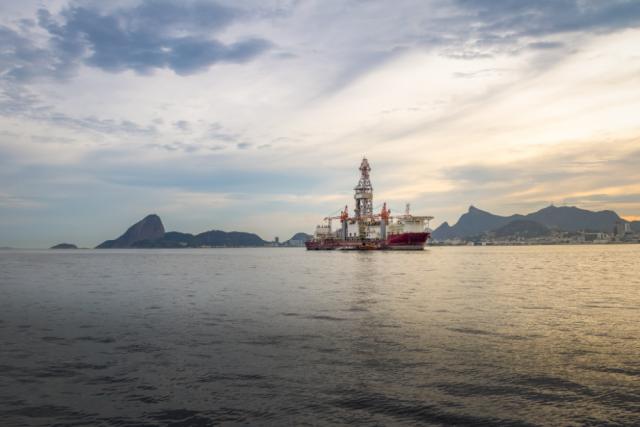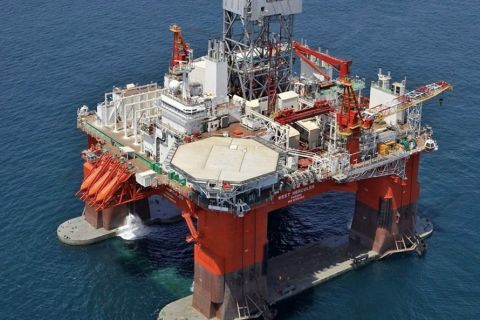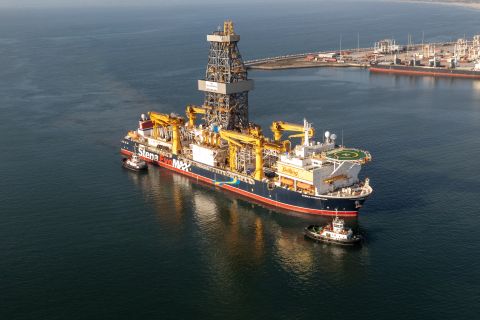
A drillship sails across Brazil's Guanabara Bay with Sugar Loaf and Corcovado in the background. (Source: Diego Grandi/Shutterstock.com)
Emerging play options are diminishing, infrastructure-led exploration is rising and cycle times are falling in an oil and gas exploration landscape being dominated by supermajors and NOCs, analysts said.
The observations were highlighted during Westwood Global Energy Group’s State of Exploration webinar this week. Companies continue looking for oil and gas, which still will be needed even as the world transitions toward a low-carbon future, to meet growing energy needs. However, as exploration budgets get smaller for some, fewer companies are drilling high-impact wells that target more than 100 million barrels of oil equivalent (boe) or frontier plays.
This year is off to a rocky start.
“To be honest, there’s not much to say about the first four months of 2021,” said Jamie Collard, senior analyst for Westwood. “Exploration results have been pretty poor. There’s only been 19 high-impact wells that have completed. So, that’s the slowest start to the year that we’ve recorded in our database.”
That’s less than half the 40 or so high-impact wells drilled in the first four months of 2020. Discovered resources are at only 0.5 billion boe, with just three potentially commercial discoveries announced, compared to more than 2 Bboe during the same time frame.
“We’re actually expecting drilling to bounce back in the second half of the year and well numbers should probably match, if not exceed, the 73 wells we recorded in 2020,” Collard added.
Deepwater drilling is also expected to bounce back.
“If we look in terms of water depth, we’re actually expecting deepwater drilling to be at its highest level since 2015,” Collard said, “and more than half of these wells are located in the Americas,” specifically the Gulf of Mexico, offshore Brazil and the Guyana-Suriname Basin.
The year, however, could also shape up to be another quiet one for frontier exploration, with only between 18 and 20 wells expected to be completed, according to Westwood.
Emerging Trends
During the last five years, analysts seen trends emerge and some appear to be sticking around.
Among these is infrastructure-led exploration (ILX). Westwood analysis show that ILX made up more than 41% of companies’ exploration budgets in 2016-2020, compared to more than 33% in 2010-2014. “This is a trend that we’re expecting to continue going forward,” Collard said, pointing out their commercial success rates have also been 50% higher than non-ILX wells. However, finding costs have been higher—$1.70 per barrel vs. 40 cents/bbl for high-impact wells. ILX discovery sizes are typically smaller.
“The companies less focused on ILX almost polarized the outcome,” he said. “The ones that were successful delivered better finding costs, but the ones that weren’t as successful, the finding costs were much higher and commercial success rates were low to zero in some cases.”
Other trends include:
Falling cycle times. Analysis showed the average time from high-impact discovery to FID was 3.7 years and 3.1 years from FID to production, halved from 2008-2015. Analysts also found that shallow water discoveries were generally drilled quicker than deepwater ones. “That’s partly influenced by license terms in areas such as Norway, requiring the well after the initial three-year period, but up to 10 years in the deepwater Gulf of Mexico, for example,” Collard said.
Deepwater moved faster from discovery to FID than shallow-water projects. “We think this is potentially due to the large flagship projects in deep water being prioritized in many companies’ portfolios.”
Struggling frontier exploration: Commercial discoveries in frontier plays are low. In the last five years, eight of 135 frontier play wells have resulted in a commercial discovery, giving a commercial success rate of 6%, Collard said.
The industry struggles to find large commercial oil plays.
“And we should mention that none of the oil plays that have been discovered since 2015, so since the Liza play offshore Guyana, even look close to being able to deliver another multibillion-barrel play,” Collard said. Forecasts showing fewer frontier wells this year and limited-scale oil plays “highlights how the emerging play options are shrinking and begs the question of could Liza be the last multi-billion barrel oil play?”
Dominating players: Supermajors and NOCs are dominating the exploration space. Equinor, Total, Shell, Exxon Mobil Corp. and BP drilled the most high-impact wells between 2016 and 2020; however, Exxon Mobil, BP, CNOOC, Hess Corp. and Kosmos discovered the most resources during that time.
“The industry is overwhelmingly targeting high-impact clastic prospects,” Collard said. “There has, however, been a slight move away from deepwater turbidites over the past couple of years as the industry drilled more high prospects in fluvio deltaic and shallow marine sands.”
This comes as many of the same companies target net-zero emissions, smaller carbon footprints and alternative energy.
However, there is no mention of the energy transition in Westwood’s analysis, said Keith Myers, the firm’s president of research. Research hasn’t pointed to any direct impact from the energy transition on the number of high-impact wells drilled and cycle times in the last five years. “I think we’re still seeing the drilling out of the legacy portfolio positions,” he said.
Looking Back
In all, the industry made 25 potential commercial discoveries in 2020 across 16 basins, Westwood data show. The largest—Vikulkovskaya (gas, 4.4 Bboe), West Irkinsky (oil, 3.7 Bboe) and Ragozinskaya (gas, 3.4 Bboe)—were made by Russia’s Rosneft.
High-impact drilling dropped by 26% with 73 wells completing, impacting by COVID-19. Before the pandemic, Collard said Westwood had anticipated between 100 and 110 wells completing.
Deepwater exploration dropped only 7% with about 40 high-impact wells drilled; however, shallow-water exploration, he said, was halved.
Also seeing a big drop last year, 44%, was frontier play exploration with fewer than 20 high-impact wells drilled, while exploration in emerging plays grew by about 7%.
“In terms of success rate, 2020 delivered a 34% commercial success rate, just one percentage point down on 2019,” Collard said, “showing again continued improvement.”
The median discovery size, however, is down to about 200 MMboe, a low that was in line with 2016. “It really shows that these very large discoveries in Russia may be masking some poor exploration performance elsewhere,” he said.
Recommended Reading
Sangomar FPSO Arrives Offshore Senegal
2024-02-13 - Woodside’s Sangomar Field on track to start production in mid-2024.
NAPE: Chevron’s Chris Powers Talks Traditional Oil, Gas Role in CCUS
2024-02-12 - Policy, innovation and partnership are among the areas needed to help grow the emerging CCUS sector, a Chevron executive said.
Orange Basin Serves Up More Light Oil
2024-03-15 - Galp’s Mopane-2X exploration well offshore Namibia found a significant column of hydrocarbons, and the operator is assessing commerciality of the discovery.
Stena Evolution Upgrade Planned for Sparta Ops
2024-03-27 - The seventh-gen drillship will be upgraded with a 20,000-psi equipment package starting in 2026.
Shell Taps TechnipFMC for 20K System for Sparta
2024-02-19 - The deepwater greenfield project in the Gulf of Mexico targets reserves in the high-pressure Paleogene reservoir.






